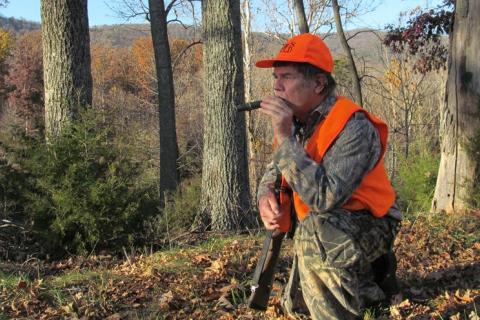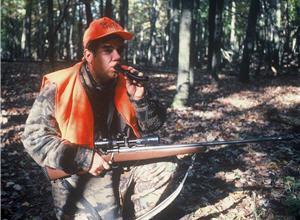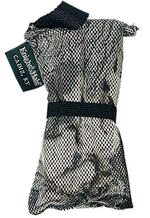
If you’re like 99 percent of whitetail hunters, you probably own a grunt call or two. But chances are good those calls spend most of the time buried in a pocket or dangling unused around your neck.
 There are plenty of situations, though, where a strategic grunt can transform a slow day in the woods into a successful hunt.
There are plenty of situations, though, where a strategic grunt can transform a slow day in the woods into a successful hunt.
Calling is a controversial subject for many deer hunters. Some swear by it, while others say it scares more deer than it attracts.
It’s true that loud rattling may scare bucks at times. A deer grunt call like the Knight & Hale EZ Grunter Xtreme, is so subtle and so common in the deer world that it rarely will alarm animals. And many times it will make a buck pause, edge closer, or step out of thick cover, offering a clear shot. Don’t just sit back and wait for success to come your way. Make it happen.
Outlined below are eight situations where a grunt can save your hunt, with details on how it can help, and tips on the best type of grunting sound to make. We’ll describe the situation that calls for grunting (Setup), what you’re trying to accomplish (Goal), and how to blow your call to achieve that goal (Tactic).
 |
| When hunting, using grunting call can help you pause or move bucks into the open for a clear shot in many situations. |
Setup 1: A buck is walking steadily past your stand.
Goal: You want to halt his progress for a good standing shot.
Tactic: Use a single loud, drawn-out grunt lasting 2-3 seconds.
Tip: This will usually give you time for a shot when the animal is still, but repeat the call if he starts to move before you get the shot off.
Setup 2: Your partner or a guide is positioned behind you trying to rattle in a buck for you. The deer has approached close enough that you caught sight of him. But he’s not in range for a good shot.
Goal: Lure him in closer.
Tactic: Blow a 1-2 second, low-volume grunt 2-3 times from your forward position. This will make him think a third buck is there.
Tip: If he still won’t come, throw an aggressive grunt-snort-wheeze at him. That will rile up even the most reluctant buck and draw him closer—sometimes at a fast run.
![]() QUIZ: Think You’re an Expert at Rattling Whitetails? Take This Quiz and See! - LINK
QUIZ: Think You’re an Expert at Rattling Whitetails? Take This Quiz and See! - LINK
Setup 3: Your decoy setup with a subordinate buck and doe looks realistic but kind of lifeless with no action or sound.
Goal: Add realism to the scene.
Tactic: Blow a series of 8-12 low-tone tending grunts. Space them about 1 second apart.
Tip: For further realism and attraction, sprinkle doe-in-estrous scent on back part of the doe decoy
Setup 4: You’ve located a mature buck hanging with an estrous doe, but he won’t leave her.
Goal: Entice the doe in. Chances are good he’ll follow her, offering a shot.
Tactic: Lure her in with low-pitched, guttural contact grunts, making her think there’s a better, deeper-voiced male to mate with.
Tip: As an alternative, play on the deer’s social instincts by using a higher-pitched doe grunt.
Setup 5: You’ve sneaked in very close to a mature buck bedding area with hot sign but nothing is stirring.
Goal: Get one or more bucks to rise from their beds and show themselves.
Tactic: Try two 1-second low-pitched grunts. You should start out very soft because bucks are very skittish and wary about danger approaching in their core area.
Tip: If they still won’t get up and offer a shot, step it up a notch and use 3-5 aggressive grunts. If that won’t stir them, back off and wait until they get up to leave their core bedding area. You don’t want to blow them out of this area where they feel secure.
 |
| Knight & Hale Ultimate Rattle Bag Deer Call |
Setup 6: You’re hunting educated bucks that have heard rattling hunters before. Plain, everyday horn-banging won’t fool these wary, mature whitetails.
Goal: Make your battle rendition super realistic.
Tactic: Start before you even clash the horns together with a couple of single low grunts to get the buck’s attention. Also rake nearby trees and pound your antlers on the ground.
Tip: For more realism, add 4-6 short, choppy grunts following each rattling session, as if the buck was winded from the battle.
Setup 7: You’re a posted hunter on a drive and deer are racing past you—too fast for a good shot.
Goal: Stop or at least slow the animals for a better shooting opportunity.
Tactic: Blow the grunt as loud as possible for 2-3 seconds. Realism isn’t the goal, stopping the animal is.
Tip: If a grunt won’t stop the buck, drop your call and try simply yelling at him. No, it’s not too realistic, but it may startle him so much he stops briefly, offering you a clear shot.
Setup 8: As you still hunt a buck appears, but his rack and vitals are hidden by brush. You’re pinned down and can’t move.
Goal: Draw him out just a step to analyze his rack and get a clean shot.
Tactic: Try 3-5 high-pitched doe contact grunts---errp-errp-errp.
Tip: If doe grunts don’t do the trick, try several short, low-toned buck grunts, about two-seconds long. Hearing both a buck and doe may rile up his competitive instincts and draw him out.
Lure in Bucks With These Grunt Call Techniques
- 4079 views

